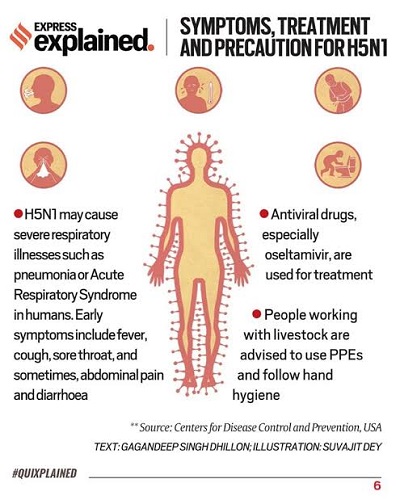Context
The highly pathogenic avian influenza (HPAI) H5N1 strain has become a significant concern globally, affecting both animal and human populations. This strain, known for its severity and potential to cause mass fatalities in birds, has now raised alarms due to its transmission to humans and its detection in cattle. Recent developments in Kerala, India, where H5N1 outbreaks have been reported, underscore the need for vigilant monitoring and comprehensive strategies to contain the virus.
The Current Situation in Kerala
In Kerala, the districts of Alappuzha, Kottayam, and Pathanamthitta have experienced H5N1 outbreaks in 19 locations since April. These regions, characterized by an ecosystem that includes water bodies, migratory birds, poultry, and integrated farms, present a conducive environment for the virus to spread. The sudden death of a large number of crows in Alappuzha, followed by the confirmation of H5N1 in their carcasses, has heightened concerns about the virus's potential to spread widely.
The state's Animal Husbandry Department has responded by implementing mass culling of birds within a certain radius of the infection sites. This measure aims to prevent further transmission among poultry and potentially to humans. However, the widespread death of crows suggests that the virus may have already moved beyond the current surveillance zones, necessitating continuous environmental monitoring and expanded containment efforts.
The Risk to Humans
H5N1 first emerged in 1996 and has since caused the deaths of billions of wild birds and domestic fowls. The virus's ability to infect 26 mammalian species, including cattle, and recent human infections have amplified concerns about its potential to cause a global pandemic. Notably, herd-to-herd transmission in the U.S. has been reported across 12 states, with the virus detected in raw milk and milking machines, indicating a significant risk for wider spread.
Despite these developments, scientists note that the virus lacks certain mutations necessary for efficient human-to-human transmission. Thus, while the risk to human health remains low, the rapid evolution of influenza viruses and the extensive spread of H5N1 suggest that more human infections could occur. The virus’s spread to animals in close contact with humans, such as cows or domestic pets, further increases the likelihood of human infections.
Symptoms and Detection
H5N1 infection in humans can present symptoms similar to those of other influenza-A illnesses, including respiratory difficulties, fever, cough, sore throat, and pneumonia. These symptoms can escalate, particularly in immunocompromised individuals or those with underlying health conditions. In the U.S., a farm worker infected with H5N1 only exhibited conjunctivitis, highlighting the variability in symptoms.
The Centers for Disease Control and Prevention (CDC) has advised clinicians to consider H5N1 in patients with respiratory illness or conjunctivitis who have been exposed to livestock or dead birds. Early detection and containment are crucial to prevent widespread transmission. In Kerala, the containment strategy involves mass culling and monitoring environmental samples for the virus. Public health officials also recommend wearing masks and using antiviral medication, such as Tamiflu, as a precaution in areas with confirmed cases.
Preventive Measures
Preventing H5N1 infection requires avoiding unprotected exposure to infected birds or animals and their environments. Individuals who have been exposed should monitor themselves for respiratory symptoms and seek medical advice if symptoms develop. Ensuring the consumption of pasteurized milk and thoroughly cooked poultry products can prevent food-borne transmission of the virus.
Public awareness and education are essential to mitigate the risk of H5N1. People living in affected areas should be informed about the importance of personal protective measures and the need for early reporting of symptoms or unusual animal deaths. This proactive approach can help in early detection and timely intervention.
The 'One Health' Approach
The concept of 'One Health' emphasizes the interconnectedness of human, animal, and environmental health. It advocates for a collaborative, multi-sectoral approach to address health threats at the human-animal-environment interface. The Lancet has recently highlighted the need for robust and coordinated responses to H5N1, stressing the importance of prioritizing and operationalizing the 'One Health' approach.
Kerala has been a pioneer in implementing 'One Health' beyond the conceptual framework. As part of the World Bank-aided 'Rebuild Kerala' project, the state has established a community-based disease surveillance network in four districts: Alappuzha, Pathanamthitta, Kottayam, and Idukki. This network includes 2.5 lakh trained volunteers who report unusual events or animal deaths, facilitating early warning and rapid response.
Conclusion
The emergence and spread of the H5N1 avian influenza strain pose a significant threat to both animal and human health. While the current risk of widespread human infection remains low, the potential for the virus to evolve and spread underscores the need for vigilance. Kerala’s proactive measures, including mass culling, environmental monitoring, and the implementation of the 'One Health' approach, provide a model for effective containment and prevention strategies. Continuous surveillance, public awareness, and coordinated global efforts are crucial to mitigate the risk and prevent future pandemics.
|
Probable Questions for UPSC Mains Exam
|
Source - The Hindu, The Indian Express







